







 |
 |
 |
 |
 |
 |
 |
 |
John William De Forest invented the term in 1868 and said that such an epic could not be written until America had "agonized and conquered through centuries." This period arrived in the 1960s. De Forest dreamed of something uniquely and indisputably American, reflecting America's self image. Nothing fits that description more than the superhero. Pulitzer prize winning author Michael Chabon suggested that "the summed output of comic books is itself the elusive Great American Novel, a collective project, of and for the people, as vast and as egalitarian as the American ideal itself. It's just a simple matter of choosing the right books." (the conclusion to Jon Adam's "the Essay", broadcast on Fri, 20 Jan 2012, 22:45 on BBC Radio 3.) It's "a simple matter of choosing the right books." Which books are best? Well what if "the king of comics" (Jack Kirby) teamed up with the greatest comic writer/editor in history? What if they then produced the greatest ever comic (see below)? What if, for the first time, a superhero comic was grounded in realism? What if that spawned the most successful comics company and revitalized the industry? Maybe that would count?
"Lee and Kirby's Fantastic Four run is the Mount Olympus of comic
book storytelling. Nothing else can touch it in its innovation,
sustained excitement, consequential events, and unprecedented character
development." (Mark Engblom in Comic Coverage: March 21, 2009)
"Stan and Jack's Fantastic Four was, at its peak, almost unarguably
the richest and most imaginative comic in the history of the medium." (Mark Waid's Fantastic Four Manifesto, in "Comics Creators on Fantastic Four" page 202.)
"Those fifty issues [FF25-75] were, simply put, the best super-hero
comics ever done and nobody, let me repeat that, nobody, has done it
better." Marv Wolfman
"For about twenty Issues, on either side of 50, it was possibly the best comic book ever done." Len Wein
"The general wisdom is that the Stan and Jack Fantastic Four is the greatest run of any comic book, ever." (Bob Reyer, comics expert on talkingcomicbooks podcast 89)
Ninety percent of comics are rubbish. Ninety
percent of every art
form is rubbish. But comics have more potential than most
art forms. Because the most efficient medium of communication is always a comic:
In religion:
If you're a living god, in the longest surviving superpower the
world has ever known, how do you teach your people about the
afterlife? With comics of course. This is from The Egyptian Book
of The Dead, telling how you are led by Anubis to the judgment
hall (frame 1), how your heart is judged (frame 2), and how you
then meet Osiris (frame 3). Medieval churches and Mayan codices
used the same methods.
|
In fine art:
If you're a great artist, and you want to tell a bigger story
than you can fit into one picture, what do you do? This is
Hogarth's story of the Harlot's Progress (click for larger
images):
|
|
|
|
|
|
In news:
If you publish a newspaper, and you want to get across a complex
idea as powerfully as possible, what do you do? You use a comic of
course. In Britain the master of the craft is currently Matt of the Daily
Telegraph: his panels are frequently quoted on BBC Radio 4's
Today program (the one the politicians listen to), as they sum up
the day's news in the most efficient way possible.
|
In entertainment:
If you plan to make a movie, or a 3D animation, you need a way
to tell the same story to your production team, but in less time
and with less money. What do you do? What medium can do the same
job as a movie but faster and cheaper? A comic of course (they
call them storyboards)
|
|
|
In business:
If you're in a meeting and need to get a message across as
efficiently as possible, what do you use? A comic of course. As Austin Kleon points out,
PowerPoint presentations (and their accompanying storyboards) are
sequential narratives using words and pictures: comics by another
name.
|
In science:
If you're sending the Voyager spacecraft into deep space, and you
want a message for any aliens out there, what do you do? You use a
comic of course. Now obviously we don't know what language an alien
would use, or if they read from left to right (or from the middle),
but we use words and symbols that tell a story: the characters say
hello, the ship is from Earth, taking this route... it's a comic! Of
course, spacecraft also take up videos and disks and stuff, but
first you have to tell the aliens how to work the thing. So you
create a story in images and symbols: comics always come first.(Image from DamnInteresting.com)
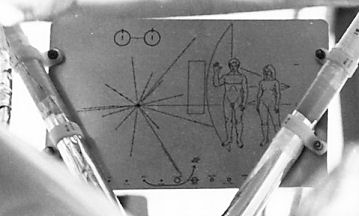
In politics:
If you're a major historical figure, and you want to tell the
world about your triumphs, what do you do? You could write a book
and just hope people read it... or you make a comic. Take the
Bayeux Tapestry, or Trajan's column, or the thousands of other
tapestries and bas reliefs around the world.
|
|
The bottom line is that pictures are good, and writing is good, but pictures and writing are better.

As a civilization reaches its zenith it creates its epic. These are usually stories that define a culture and can be understood by children, but also have depths for adults. Hence the Iliad, the Aeneid, Beowulf, the 1001 Arabian Nights or European Fairy Tales. These are usually collective works spanning many years, featuring god-like heroes.
The epic often draws on sources popular
at the time, and retells them in a way that fits a certain
point in history. As Philip
Pullman has observed, Grimm's fairy tales are about princes
and castles and children's suffering after the Thirty Years war
and Napoleonic wars, which led to the unifying of Germany. The
1001 Nights reflect the new cities of the Islamic civilization in
Arabia and the problems that arise for a previously nomadic
culture. Likewise, the superhero reflects America becoming a
global superpower and moving into space. The Fantastic Four
specifically reflects the triumph over the soviets, 1961-1989.
This is explicit in the first issue: private enterprise, science
and family beat the communists.
The FF represented the zeitgeist of the day. As Darcy Sullivan observes, the Fantastic Four is "an allegory, a secret history of the 1960s":
The allegory goes far beyond the individual characters and stories:

The Great American Novel is "the most accurate representative of the zeitgeist in the United States at the time of its writing."
The zeitgeist is the spirit of the age:
Jack Kirby worked with both the radio and TV constantly on, with the TV sound turned down. His mind was like a sponge for current ideas (see volume 1 of the Comics Journal collected interviews). He frequently produced ideas that later found their way into more famous media. For example, when I read the first Challengers of the Unknown I thought it was ripping off the movie "Jason and the Argonauts" - but he movie was four years later. And when I began to notice his repeated references to spraying vapour that improves our DNA (Challengers 8, Terrigan mists, etc) I had to check that these came before Philip K Dick's "Ubik". Kirby also referred to the time when he wrote a story about the atom bomb before it became widely known, and was visited by government representatives asking where he heard of it. He had picked up the details from science magazines and it just seemd obvious to him that such a thing would one day be made. Kirby was perhaps the greatest ever pipeline for the zeitgeist to the printed page.
Pop art: "The state, culture, and perspective of the common American citizen."
Perhaps the purest example of the zeitgeist in art is "pop art." Pop art brings together the ordinary and familiar to represent the spirit of the age. The Fantastic Four is pop art, and was re-branded as such at the start of its golden age (issues 42-46).

In General, the FF is about American optimism, America's family values in tension with individualism, and the nation's rise to being the sole superpower. The characters have superpowers because America is a superpower. The story begins when the space race hots up (1961, the first man in space) and ends when the cold war ends (1988-89). Each decade is reflected in the stories. It goes without saying that the clothing, hairstyles, cars and attitudes all reflect the contemporary fashions. For the zeitgeist of each year and each month, see commentary on individual issues.
The 1960s:
This decade is about the cold war and space race, and endless
American optimism. The FF is led by a scientist with 1950s
patriarchal values, who uses giant machines: a symbol of early
America's 1960s faith in science and technology to solve all the
world's problems.
But at first there is a strong undercurrent of alienation as conservative ideas from the 1950s are questions and found wanting. Civil rights is also there: the underlying theme of the FF is equality; the FF featured stories on hate at the time of JFK's assassination; they had the first black superhero, and his title (the Black Panther) predates the revolutionary organization.
Mass
culture:
Individual issues are almost a checklist of popular mass culture
of the time. Cultural homages include:
...and many more.
The 1970s:
This decade is about self doubt and disharmony. The optimism ends:
overstretched, Reed is sick for most of the decade (reflecting
Vietnam, Watergate, and national self doubt. etc.) Reed collapses
through over work, Reed and Sue separate, both are worried and
miserable for the early 1970s, they are reconciled, but the old
naivety is lost. Reed loses his powers and the team disbands. The
theme of feminism is particularly clear, with the once most
powerful male on Earth reduced in the public mind to to a second
rater, a teddy bear, after being humbled in a public ally staged
fight with a warrior from an all-female planet. A warrior who then
recognizes him as the only male she can admire and respect: a new
status quo is achieved.
The 1980s: money and property,
women in charge, etc.
Examples of real world themes from the 1980s are the rise of right
wing family values as a political wedge issue, the rise of Wall
Street, and women in positions of real power. These are of course
reflected in the FF. Property ownership is everywhere:
1980s style Conservatism is reflected in John Byrne's run, an
attempt to get "Back To The Basics." Sue becoming thinner (with a
bigger bust of course), and more violent, and loses a baby. The
change to a dominant, cropped haired Alicia is also notable.
The Great American Novel must be written by "An American author who is knowledgeable about the state, culture, and perspective of the common American citizen" (Wikipedia).
Everyone who creates the FF openly states that they are following
the vision of just two men, Stan Lee
and Jack Kirby.

Lee was a likeable huckster who dreamed of
Hollywood. Kirby was a tough street kid from a poor
neighborhood, an avid consumer of pop culture. Both men were Jews,
New Yorkers, and WWII veterans. Lee and Kirby were
America personified.
The Fantastic Four had a third author: the readers. The comic listened and gave them what they wanted.
This author is "knowledgeable about the state, culture, and
perspective of the common American citizen" because he and she is the American citizen!
What was the average American reading? Not Melville, not Hemingway, not even Twain. They were reading comic books, because comic books spoke their language.
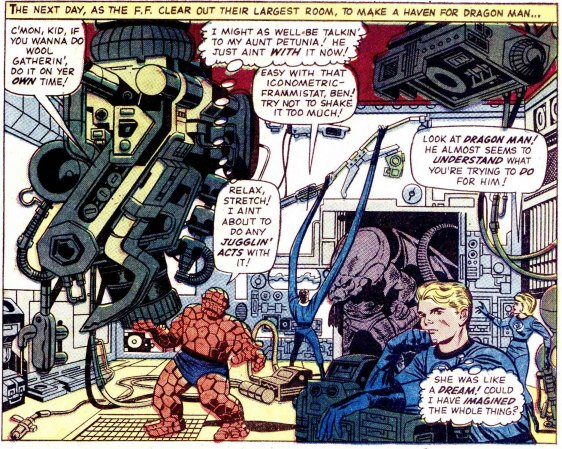
Regarding popular literature in general, the "tortured
powerhouse" was invented with The Thing. The idea that a being
could be genuinely unstoppable, and loved, yet still hate
himself, is a reflection of modern day insecurities.
Regarding comic books, the Fantastic Four gave rise to the silver age of comics, when superheroes were taken seriously. Other comics and companies soon followed, but any reference to superheroes that takes the idea seriously has the Fantastic Four to thank.
The book had a more direct influence on certain novels and movies. For example, regarding Reed and Sue breaking up in issue 129, "Decades later, novelist Rick Moody would describe this story line in 'The Ice Storm,' his roman a clef about familial disintegration." ("Marvel Comics: The Untold Story" by Sean Howe p. 139). "The Brief Wondrous Life of Oscar Wao" by Junot Diaz opens with a reference to the FF: "Of what import are brief, nameless lives, to Galactus?" and refers to the FF in many places. The story of the Silver Surfer features prominently in the 1983 movie "Breathless" with Richard Gere, and the hit movie "The Incredibles" was a thinly veiled pastiche of the FF.
But generally the qualities of the FF have not yet been
recognized. Even fans treat the comics superficially, mocking
issues they do not understand (such bas FF 80, Tomazooma). This
web site exists to persuade people to take a closer look.
Before the 1960s, the word "fantastic" had the primary meaning of "impossible" and sometimes "grotesque." It was occasionally used to mean "wonderful" but that sense was rare, even trivial. However, "In popular usage, the word 'fantastic' has become a casual term of approval, a synonym for 'great' or 'brilliant', and this has to a great extent supplanted the original meaning of the word." We see this in one of the earliest ads for the Fantastic Four, from early 1962: the greatest "Fantasy Magazines" include "The Fantastic Four" with "America's greatest "fantasy characters".

When did the change from "impossible" to "good" occur? The "impossible" meaning was still
dominant until the 1960s in academic texts. But by the late 1960s
"good" was the common meaning, hence in Britain we had a comic
imprint called "Power comics" with the titles "Pow," "Fantastic"
and "Terrific": by the late 1960s the terms were interchangeable and
commonplace among the young. As for the older generation in 1973 structuralist critic Tzvetan
Todorov was the first academic to reflect the new meaning. In his
work "The Fantastic", the "impossible" meaning was shifted to mean
not impossible, but
instead the uncertain area between
the impossible and the possible. That is, something exciting,
something that attracts our interest.
So something happened in the 1960s to change the word meaning in the
minds of the young. What was it? The movie "Fantastic
Voyage" released in August 1966 is one candidate, but this was
only a few months before Britain's Fantastic comic (February 1967) so by
then the "good" meaning was already common. Besides, the movie only
appeared briefly (this was long before video) and was intended for all
ages: the change we are looking for took place earlier, mainly among the
young, and was around for long enough to make a difference. What were
young people reading month after
month? Comic books. What were most influential comic books at the
time? Marvel comics. What was the flagship title, the first and biggest
seller? The Fantastic Four.
In 1961 the name "fantastic" was chosen because it
suggested the impossible. By 1966, the highpoint of the comic (see Galactus, etc.) it had redefined
the word to mean wonderful. For more details, see Todorov's "The Fantastic",
or chapter 1 of Robert Papetti's "Fantastic Four In The Silver Age Sixties: A
Tribute".
In addition, the Fantastic Four expanded the horizons of
literature by making the most extreme form of fantasy (the comic
book) believable. It was the first mainstream comic to feature a
black hero (who unlike other black characters then got his own
title). "New York Times
editorialist and race-relations historian Brent Staples,
[remarked on] how archetypal loners, literally caught between
worlds, like the Silver Surfer, resonated with his experience as
a Black reader in a racially divided country more than did the
handful of 'minority' characters introduced in those times
ostensibly for readers of color to identify with." (ibid)
The book also snuck underground rebellion and the drug culture
past the then-rigid Comics Code Authority, through stories like
the Inhumans (a secret race of enhanced beings hiding underground
in New York, with their roots in a great refuge hidden in the
Tibetan mountains) and the metaphorical drug trips of FF76-79.
Influence on other comics
Marvel became the biggest selling American comics publisher by far, and
all other publishers (that share the same markets) are heavily
influenced by the Marvel style. And all modern Marvel comics are
tributes to the Fantastic Four. This was stated by Tom Brevoort, in
response to a question on why the Avengers and X-Men have so many
spin-off books but the FF apparently do not:
"Every book in the Marvel line is a
franchise expansion of FANTASTIC FOUR. It’s just that, in the 1960s,
they tended to do this stuff differently than we do it today. But X-MEN
was created specifically in response to publisher Martin Goodman’s
desire for 'Another FANTASTIC FOUR.'” (source)
Many people have commented on how Star Trek pushed the boundaries
of popular culture, but the Fantastic Four usually did it first,
and to a wider audience. TV shows had much higher initial audiences, but comics
reached more people and in a more intense way.
Who was first?
Who came first matters. Each change establishes a precedent and
encourages others to go further. An early subtle change may then
be more significant than a later more blatant change. So it
matters that the Fantastic Four (1961-) came before Star Trek
(1966-69).
How did they pushing the cultural boundaries? Let us take the
most famous Star Trek example: the interracial kiss, in 1968. In
this, Kirk was mind controlled, and had little choice. What
message does that send? "I will only kiss another race if I have
no choice"? In contrast, between 1962 and 1964 Sue Storm had a
genuine romance with a member of another race: Prince Namor. Since
1965, Johnny Storm has been in love with Asian Crystal and
frequently kissed. Crystal is actually a member of another race
that includes a man with hooves and another man with green scales
and fins! Nothing says interracial more than the Inhumans - if you
want to discuss prejudice, just look at their name, they were
Inhuman, he found them living underground in the run down inner
city area of New York, yet Johnny loved her. Or if you want a
positive black role model, how about their close friend the
scientifically and culturally advanced Black Panther? Or if you
really want to focus on a different skin color and romance, this
was a dominant theme for The Thing since 1961. The message of
tolerance in the Fantastic Four is not as blatant as a token
female and single kiss, but it runs much deeper, it's not an
intentional attempt to be liberal, it's just a natural growth from
the story. Race relations is about more than skin color. "New York Times editorialist and
race-relations historian Brent Staples, [remarked] on how
archetypal loners, literally caught between worlds, like the
Silver Surfer, resonated with his experience as a Black reader
in a racially divided country more than did the handful of
'minority' characters introduced in those times ostensibly for
readers of color to identify with." (source)
Which reached more people?
What were Star Trek viewing figures? "The first season was 15 million, second season was 14
million, third season was 10 million. (Making of Star Trek V, p.
42, Harve Bennett.) He also added that a shot needed to have 20
million to be a success." (source)
Star Trek figures declined and it was canceled. In contrast, a
typical issue of the Fantastic Four in the mid 1960s sold one
third of a million copies, and every year sold more than the year
before (until 1968). At first that seems like a slam dunk for Star
Trek. But early Fantastic Four stories were simplified into TV
cartoons at the time, so that raises their profile. And that's
just the start.
The flagship for an interconnected universe: what started in the
Fantastic Four was then expanded elsewhere. For example, the idea
of heroes being hated was expanded in Spider-Man. The cosmic
elements were expanded in the pages of Thor. The Silver Surfer and
Black Panther got their own comics. It was all part of a single
story. Taking that story as a whole, Marvel
comics
sold around 8 million issues a month. This continued month
after month, year after year, whereas Star Trek was only on TV for
three seasons. In the 1960s there were no domestic video players,
so each Star Trek episode was seen only once, or twice if you were
lucky to catch a rare repeat. But a comic book could be read again
and again, passed around friends, and sold on. It is safe to say
that in the 1960s the Fantastic Four universe reached more people
than the Star Trek universe ever did.
Which reached more young people?
Star Trek's modest viewing figures are often defended on the
grounds of demographics: these were all young people, right?
Actually, no. "According to
Television Magazine, the four episodes broadcast between October
27th and November 17th, 1966 averaged 8,630,000 viewers in the
18-to-49 age group, making up 43% of the show's total audience
[51]. By comparison, during the same period ABC's Bewitched
(which aired opposite Star Trek from 9:30-10PM) averaged
10,210,000 young adult viewers or 37% of the total audience." (source) Note that "young" back then
was anything up to age 49! In contrast, the vast majority of
Marvel readers were under 20, and many were under 10 years old.
The younger a person is, the more a story is likely to influence
them. In demographics, the Fantastic Four wins hands down.
Which was read more intently?
Star Trek fans have done a much better job of getting their material in front of critics. This is due to:
In the 1960s, the Fantastic Four probably had a greater cultural
influence than Star Trek. But that is not obvious unless we look
at the numbers at the time.
The story follows the classic five act structure: danger, rising action, the ball, crisis and triumph:
Act 1: danger:
The story begins with the crucible that forces the heroes
together: the space flight. The grand quest is then laid out: Reed
wants to save the world, and Sue wants them to be a family. The
four major themes are introduced (reluctant heroes, personal
confidence, the American Dream, and equality), along with the
principle opponents (Doom, Namor, Skrulls) and motifs (would-be
monarchs, hidden races, dangerous frontiers, health, mind control,
doppelgangers and home).
Act 2: rising action:
Here the themes and motifs are expanded and threats
multiply. At the start of this act, threats appeared only at
intervals. By the end of the act, each drama merges with the next.
Act 3: the ball:
All the characters get together (the wedding), and
everything looks bright. This act crystallizes the major themes in
the person of Franklin and hence the need to put family first.
Act 4: crisis:
Everything goes wrong. Reed can no longer cope. There is a
false triumph and false dawn half way through (FF200) then things
get even worse.
Act 5: triumph:
The crises are finally solved through family values: Reed accepts
what Sue was telling him all along and all their problems are
neatly resolved, leaving to the start of the next epic.
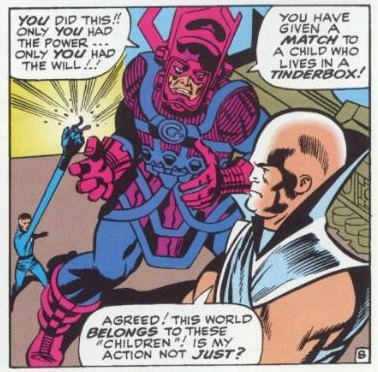
The FF is probably the most layered book ever written. At least twelve layers of story are told simultaneously, and each layer can include multiple characters. Why is it so complex? Because it evolved organically through multiple people. The result is far richer than any individual could consciously achieve. Layers include, from smallest to largest:
Most of these layers are hidden at first glance. People often pretend all is well when they are hurting inside, or they may not see the importance of an event until years later. But look for the depth and it's there.
Each issue typically introduces a new short subplot, but some subplots extend over all or most of the entire 28 year story. Each has its own beginning, middle and end.
Individuals:
Races, empires, and others:
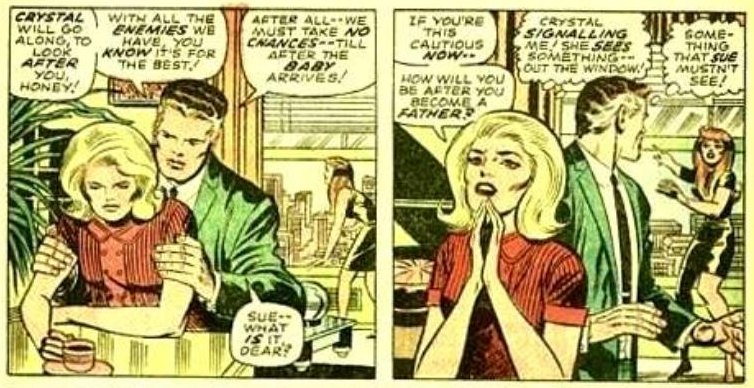
The most obvious themes are right there on the cover to issue 1:
These themes are so obvious that they won't be discussed in depth
on this site. Instead we shall focus on the secondary themes:
concerning teamwork.
In many ways this is the story of Susan Storm, and a metaphor for every mother who feels the heavy burden of duty while seeming to be invisible. Susan never had a proper childhood (her mother was dead and her father in jail), and had to raise her younger brother while barely more than a child herself. All she ever wanted was a normal family life, but fate had other plans. Instead, she had to save the world, as a superhero with almost no power (at first) and no respect. The Fantastic Four is the story of how she persuades her husband to notice her, and through her to notice his family, and finally put them first.
The first issue introduces the four themes (reluctant heroes, personal confidence, equality and the American Dream) and these are developed through the story and are resolved in act 5. As we would expect in The Great American Novel, these themes also apply to the United States in this period.
We must be heroes even though we don't
want to be.
Reed, Sue and Ben never wanted to be superheroes. Johnny is the only one who loves the lifestyle, and he is in the shadow of the others. By the end Reed and Sue finally get the life they want, and Ben and Johnny are well on their way.
This reluctance mirrors the United States' Founding fathers who wanted to avoid European wars, but their nation finds itself involved in almost every conflict on the planet.
Success depends on confidence.
Reed's tragic flaw is his belief that only he can solve everything
(a flaw taken to its extreme with his mirror, Dr Doom): this
confidence is gradually undermined through the story (reflected in
his health), until he gains respect for others. Ben's story is one
of regaining his confidence, Johnny loses his, and Sue becomes
more assertive on the surface while losing confidence under the
surface. At the end, all find their true selves.
This all reflects America's initial pride in the 1960s (faith in science, expanding business, moon landing, etc.), loss of confidence in the 1970s (Watergate, oil crisis, Vietnam, etc.), and finally winning the cold war in 1989, when the 28 year Fantastic Four story ends.
All men (and women!) are created
equal.
The whole story can be seen as one of sexual equality: Sue's
apparent weakness (she prefers listening and caution to fighting)
is more effective than Reed's hard power (conflict), which
increasingly fails. Those who appear to be enemies are sympathetic
and can become friends (the Mole man, Namor,etc.). Sue's softer
role is crystallized in Franklin: he appears to be a liability, a
baby in need of saving, but is in reality the most powerful one of
all. Both Reed and Doom, the proudest of all, are finally defeated
by their children. Meanwhile, Ben learns to stop ignoring Alicia's
needs and abilities (for example, Alicia is the only one who can
stop Galactus), Johnny learns the hard way not to be sexist, and
Doom learns that his success depends entirely on the respect he
gives to Latverian peasants.
This reflects America both internally (civil rights, women's
liberation) and externally: America's soft power through trade and
entertainment, which treats other nations as equals, is far more
successful than its hard power through forced regime change, which
tries to treat other nations as naughty children.
Anyone can make it, and have it
all.
The American
Dream is the national ethos of the United States, in which
freedom includes the opportunity for prosperity and success for
everyone, through hard work and decency. Reed achieves everything
through his genius; Ben was an ordinary kid from a tough
neighborhood who became a war hero and star test pilot through his
hard work; and. Johnny and Sue are orphans who, through Sue's hard
work and their courage (joining the dangerous space flight) became
celebrities. The team is shown as having a penthouse suite, global
fame, a flying car, and everything people dream of. Several early
stories praise office work and celebrity culture.
Historically the Dream originated in the ever expanding frontier,
a central motif of the Fantastic Four. It was particularly marked
among 19th century Jewish refugees: both Stan Lee (Stanley Lieber)
and Jack Kirby (Jacob Kurtzman) were Jewish, as is Ben Grimm in
the story. Most of the team's early foes are old world style
monarchs or attempted monarchs: Doom, Namor, the Mole Man, Kurrgo,
Puppet Master, etc.
The story also reflects criticism of the Dream: the team also reinforces class inequality: Reed had a genius was a millionaire whose father was an equal genius, Sue and Johnny's father was a star surgeon, and Sue benefited from movie star looks: the only completely self made member was Ben, and he gets the ugly treatment and is treated like an idiot by Reed and Johnny. Reed, the highest achiever of all, realizes that no amount of effort will guarantee success (in act 4). But this is simply a reflection of the true American dream: a happy family based on good values. Their happiness and ability to solve problems ultimately does not depend on their wealth but on whether they treat each other with respect (see the major theme of equality).
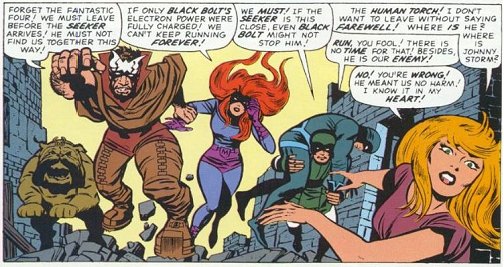
The story features recurring motifs including:
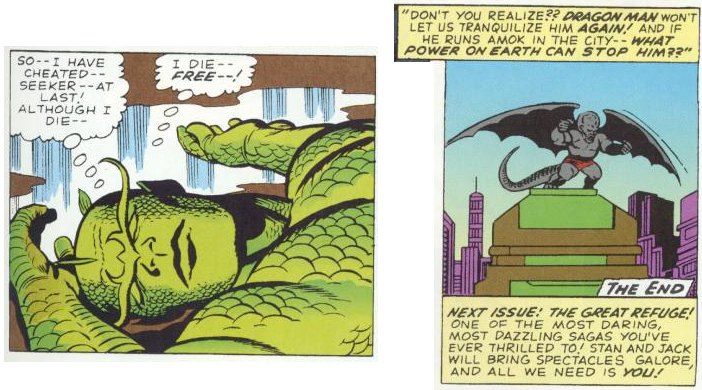
The Fantastic Four is the Great American Novel. It is therefore the modern Shakespeare.
The Fantastic Four is an allegory of the most powerful nation in the history of the world, during its triumphant phase: from its first man in space (1961) to the end of the cold war (1988-9). A nation is understood through its art, and the superhero comic is America's unique contribution to art. (Western movies are also unique contributions, but no movie spans so many years or topics.)
The Fantastic Four is the only realistic mass market superhero
comic (no flashy costumes or
secret identities), and the most literary (they form a
single coherent story).